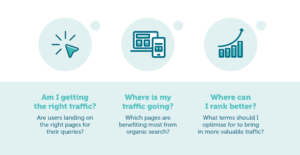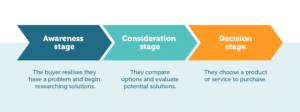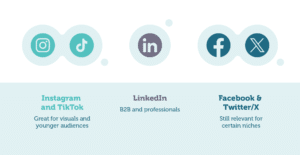
Getting website traffic is important, but getting quality website traffic is what really counts. Otherwise, it’s like throwing a party and only your weird neighbour who talks about conspiracy theories shows up. You want to attract the right people, those who actually care about what you’re offering.
Whether you’re starting fresh or trying to recover from a sudden drop in traffic, the key is attracting the right audience. We all love a good up-and-to-the-right graph, so let’s talk about how to make that happen.
What is quality traffic?
Not all website visitors are created equal. Quality traffic refers to visitors who are genuinely interested in your products or services and are more likely to convert. This might be making a purchase, signing up for a newsletter or engaging with your content in a meaningful way.
However, quality traffic doesn’t always mean an instant sale. In industries with longer buying cycles, visitors may need time to research before they commit. Some might not convert directly but could refer your site to others who will. The key is that quality traffic has a clear link to your business goals, whether that’s immediate revenue, brand awareness or customer engagement that eventually leads to sales.
So, while it’s tempting to chase big numbers, what really matters is attracting relevant traffic that aligns with your business objectives. After all, 1,000 engaged visitors are far more valuable than 10,000 who bounce immediately without taking any action.
Make sure you can be found
If search engines can’t find you, neither can potential visitors. And if they can’t find you, you can forget about conversions. So let’s make sure your site is in top shape for visibility and more website traffic.
Check out Google Search Console
Think of Google Search Console as your personal website health check-up. This free tool tells you if Google can find your site, what issues might be lurking under the hood, and how well you’re ranking.
It also shows:
- The search queries bringing traffic to your website
- How often people click on your site (or ignore it - ouch)
- Mobile and desktop performance insights
So if you haven’t checked your Search Console in a while, now’s the time to right that wrong. Fix those errors and let Google work its magic.
Set up your robots.txt file
The robots.txt file might sound like scary coding stuff, but it’s actually just a simple text file telling search engine bots where they can (and can’t) go on your site. Sometimes, people accidentally block their entire site - far from ideal.
Check your file (www.yourdomain.com/robots.txt) and make sure you’re not accidentally telling Google to get lost:

Using Google Search Console to review search queries
One of the best ways to understand how people are finding your website is by using Google Search Console (GSC) to review the search queries you’re ranking for. This can give you insight into what is already driving traffic to your site and highlight opportunities for optimisation.
Reviewing queries for your entire site
By analysing the search queries your site is ranking for as a whole, you can:
- Identify key terms that are already bringing in traffic.
- Spot high-impression but low-click-through queries that could be optimised.
- Discover new keyword opportunities to target in your content strategy.
Checking queries for key pages
It’s not just about your website overall - you should also check how individual pages are performing. Reviewing the queries that drive users to specific pages can help you:
- See if the right terms are leading to the right content.
- Find pages that have ranking potential but need better optimisation.
- Improve existing content to target more valuable traffic.
Answering key questions
Using GSC effectively allows you to answer crucial questions about your website’s traffic, such as:
By leveraging these insights, you can refine your SEO strategy to attract more of the right visitors and ensure your content is aligned with what users are actively searching for.
What does your sitemap say?
Your sitemap is like a treasure map for search engines as it tells them where to go. Make sure it’s up to date, error-free and pointing search engines to the right pages so they can drive more traffic your way.
Structured data (Schema Markup) is becoming even more critical. If you’re not using it yet, now’s a great time to start.
Know your target audience
If you try to appeal to everyone, you’ll end up appealing to no one. That’s why understanding your target audience is essential in digital marketing. The better you know them, the easier it is to create content that actually resonates and encourages people to engage and, ultimately, spend their money with you.
Who are you talking to?
Defining your ideal customers helps you craft the right message, tone and content. But what is a buyer persona and how do you create them? If you’re not sure where to start, use a buyer persona template to map out who they are, what they want, what their problems are and where they hang out online.
What does the buyer’s journey look like?
People don’t just wake up and decide to throw money at you (unfortunately). They go through a process known as the buyer's journey:
If you’re not answering their questions at each stage, you’re missing out on potential customers.
AI chatbots can now help answer these questions in real time, keeping visitors engaged. A handy tool for both you and your audience, as it can free up your time and make sure you provide potential customers with information as and when it's needed.
Using search data to build a seed keyword list
By combining insights from the Google Search Console review with your understanding of the buyer’s journey, you can build out a list of seed keywords. These are the initial terms to track and investigate further through keyword research, as we can assume that the terms your buyer personas are interested in will drive quality traffic. This approach ensures that your content strategy aligns with user intent and business objectives, leading to better search rankings and higher conversions.
Align your marketing strategy to your target audience
Now that you know who you’re talking to, let’s make sure your marketing strategy is laser-focused on reaching them.
Keyword research
If you want free website traffic, you need to rank for the right keywords.
Here’s what you should do:
- Research what people are searching for.
- Check if you already have content covering these topics.
- Expand or improve your existing content where needed.
- Create new content to cover the gaps.
Google’s AI updates are shaking up search rankings. Optimising for long-tail keywords and featured snippets is more important than ever.
Where should you be marketing?
There are plenty of ways to get more traffic, but not all of them will work for you. Similarly, a blended search approach (a combination of tactics deployed at the right time) can be highly effective. Let’s break it down:
Organic traffic (SEO): A non-negotiable
This is the best kind of traffic because it’s free (and who doesn’t love free stuff?) and sustainable. But it requires work through SEO, such as writing blog posts, optimising your pages and getting quality backlinks. For more information on optimising your content, read our dedicated blog post.
Paid advertising (Google Ads and AI-powered ads): A necessary evil
Sometimes, you have to spend money to make money. Ads are sometimes necessary in highly competitive spaces where ranking might be hard. Paid ads can be profitable if done right as part of a blended search strategy. The key is to target:
- Relevant searches
- High-converting audiences
- The right locations and times
Digital PR: Getting your name out there
Digital PR is all about building brand awareness, credibility and trust online. This includes:
- Earning media coverage from relevant websites and news outlets
- Getting mentioned by influencers and industry leaders
- Writing guest posts to showcase your expertise
- Engaging in online discussions and thought leadership
A well-executed Digital PR campaign boosts your reputation and can help you gain quality backlinks, improving your search rankings and generating traffic to your site.
Social media sites: Yay or nay?
Some businesses thrive on social media platforms, others not so much. Focus on where your audience hangs out:
Short-form videos (Reels, TikTok and YouTube Shorts) are dominating engagement. If you’re not using them yet, it’s time to start.
Referral traffic: Your secret weapon
This type of traffic comes from relevant websites linking to yours. Getting guest posts, industry mentions or collaborating with partners can send a steady stream of website visitors your way.
Email marketing: Old but gold
People might leave your site, but that doesn’t mean they’re gone forever. A smart email marketing campaign keeps them engaged and brings them back when they're ready for your products or services.
There are three main types of marketing emails:
- Remarketing emails: These emails help re-engage visitors who have interacted with your site but haven’t yet converted. Whether it’s an abandoned cart reminder, a follow-up on a viewed product or a special offer to bring them back, remarketing emails keep your brand top of mind and encourage users to return.
- Nurture emails: Designed to guide potential customers through the buyer’s journey, nurture emails provide valuable information at each stage. From educational content to case studies and testimonials, these emails help build trust and move users closer to making a decision.
- Promotional emails: Everyone loves a good deal! Promotional emails focus on special offers, discounts and exclusive deals to encourage conversions. Whether it’s a limited-time sale or an exclusive early-bird offer, these emails help drive sales and engagement with your brand.
Yes, privacy updates and regulations have made email tracking trickier. But, if you focus on personalised, high-value content sent to an audience that opted in, you'll keep engagement rates high.
Google Analytics: Keep an eye on what's working
If you’re not tracking your efforts with Google Analytics, you’re flying blind. Monitor where your web traffic is coming from and what’s converting, and tweak accordingly.
Fix broken links: Your SEO depends on it
Nothing says unprofessional like clicking a link and landing on a 404 error. Fix broken links regularly to keep both search engines and visitors happy.
Conclusion
Now you know how to define what high-quality traffic is, how to identify your target audience and the channels to use to reach them. With this knowledge, you can develop a strategy that puts your brand in front of the right people at the right time. Whether it’s through SEO, paid ads, email marketing or social media, focusing on quality over quantity will lead to better engagement, stronger customer relationships and ultimately, more conversions. So, go forth and drive traffic that actually matters!
Need help driving more website traffic to your site? Let’s chat about how to level up your strategy.









